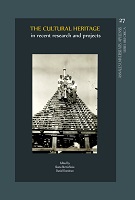Primele investigații dendrocronologice extinse la bisericile de lemn din Sălaj (2018-2023)
The first extended dendrochronological investigations at the wooden churches in Sălaj (2018-2023)
Author(s): Bogdan Ilieș, Boglárka Tóth, Patrick ChiroiuSubject(s): Cultural history, Museology & Heritage Studies, Architecture, History of Church(es), Present Times (2010 - today)
Published by: Editura Mega Print SRL
Keywords: cultural heritage; sacred wooden architecture; historical architecture; dendrochronological analysis; Romania;
Summary/Abstract: This paper presents the results of extensive dendrochronological investigations applied to an initial group of ten wooden churches in Sălaj County (Map 1), north-western Romania. The dendrochronological analysis of historical structures was first used in Romania as a method for gaining in-depth understanding prior to the year 2000. Decisive steps were taken back then, notably through the research of architect Alexandru Baboș in Maramureș (conducted during his doctoral studies in Lund). Moreover, in the last two decades, under the influence and experience of projects from abroad, this type of study has increasingly been applied to historical monuments in general. A few researchers in Miercurea Ciuc, Suceava or Timișoara have begun to work intensively on developing and validating increasingly rich and specialized databases focused on historical provinces and wood species. However, out of the estimated 1,400 historical wooden churches believed to exist in Romania, fewer than 100 have benefited from this scientific method. These are primarily concentrated in Transylvania, Maramureș, Crișana, and Banat, while in the rest of the country, analyses remain sporadic. Furthermore, the results of the investigations are not nationally centralized (initiatives being rather private and NGO-based), and researchers (very few in number) do not manage to publish them systematically. Therefore, one of the objectives of this paper is to make public the dendrochronological results obtained in one of the country's counties, Sălaj, between 2018-2023. Another objective is more specific, targeting precise corrections and confirmations related to the age and construction stages of the wooden churches in Sălaj, in order to create exact chronological benchmarks, grounded in science, to support future comparative analyses and studies, but also to correct the List of Historical Monuments in Romania or promote these monuments in hope to ensure their preservation. The old and new datings for foundations and repairs or renovations from the 17th to 20th centuries are shown side by side in Fig. 10, highlighting the value and necessity of the methods of collecting scientific data, in cases where existing bibliography is strongly impregnated with myths and centuries-old information, insufficiently verified or impossible to verify otherwise. The study also reflects the fact that, in the years 1750-1770, there was an impressive constructive surge in Sălaj, characterized by the erection of new churches or modifications to the existing ones. If this mid-18th century constructive effervescence is confirmed, the phenomenon inquires further investigation within broader historical, social, and confessional context. Additionally, to precise information for the history of religious buildings, the study also provides a series of historical evidence about the craft of carving and wood usage in the architecture of Romanian communities in the area over four centuries. This paper marks the first stage of valuing the chronological data from Sălaj, a second group of 21 churches in the same area being planned for research during this year (2023).
Journal: Annales Universitatis Apulensis Series Historica
- Issue Year: 27/2023
- Issue No: 1
- Page Range: 1-34
- Page Count: 34
- Language: Romanian
- Content File-PDF

